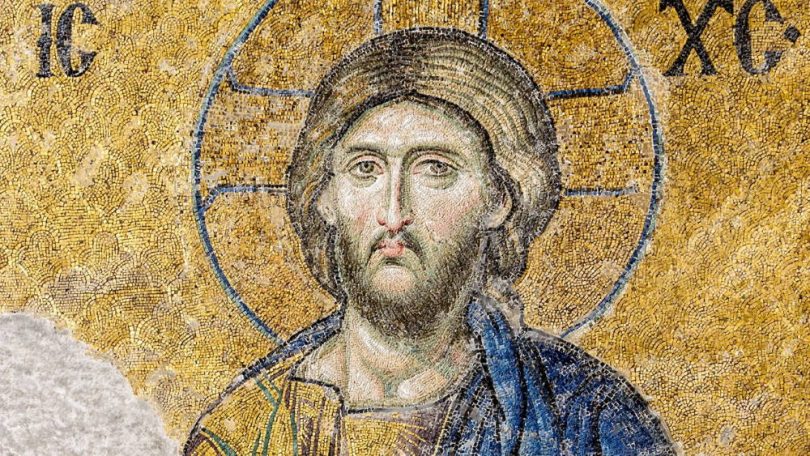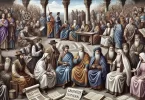During his lifetime, Jesus did not call himself God. His disciples did not consider him to be God. It is implausible that Matthew, Mark, and Luke did not mention that Jesus called himself God. The Gospel of John is providing a theological understanding of Jesus that may not be historically accurate. As time goes by, Christians started calling Jesus “God” which created a conflict when the Romans started calling their emperors “God”. Christians created a rivalry between your God, the emperor, and our God, Jesus. In the fourth century approximately around the year 325, Constantine, the Roman emperor, converted to Christianity, or converted the Roman Empire to Christianity, it changed everything. Now, rather than the emperor being God, the emperor was the worshipper of the God, Jesus or the worshiper of the ‘Son of God’. The relationship between religion and politics changed for ever.
If Christianity had not become a significantly noticeable group in the Roman Empire, the Roman emperor Constantine would likely not have converted. Then, there would not have been the large number of conversions after Constantine. Christianity would not have become the dominant religious, cultural, political, social, economic force that it became. Our world would be very different to the world as we see today.
It is clear that the writer of the Gospel of John believed Jesus was God. The Gospel of John is considered by New Testament scholars to be the latest of the gospels to be written — composed sometime between 90ad and 120ad. The earlier books of the New Testament were written between 50ad and 90ad. They do not contain the claims that Jesus is God. What appears to have happened that the earlier Jesus sect members didn’t believe Jesus was God. The Jesus-God relationship developed later somewhere from the year 100ad, approximately the time the Gospel of John was written. The Jesus-God relationship became the dominant thought train in the early second century. Christians have come to understand all the wording is synonymous with “God in human form”. Thus other passages seem to confirm that Jesus claimed to be God.
So, what Jesus said and what is written in the gospels may not actually match. The gospels were written by the early followers of Jesus. So they must have been the stories passed from generation to generation. People were likely better at remembering in those days as they did not have alternatives to memories. Around the year 325, the Roman emperor got involved and so strong influences on accepted thinking came about.
Constantine was accepted as a Christian after the Battle of Milvian Bridge and is considered to be the first Christian emperor. He was not baptized, however, until he was on his deathbed and called for a priest, shouting “Let there be no ambiguity.” In the year 313, Constantine issued his ‘Edict of Milan’ which gave every person the right to practice any religion they wanted. Constantine thus formally recognized Christianity and put an end to the persecution of Christians. Although he converted to or accepted Christianity, he was still paying attention to other deities. He patronized Christianity in lavish ways. This was the important turning point in Christianity. He actively promoted the Christian Church, yet was not baptised into the faith until on his death bed. Throughout his life he also acknowledged Sol Invictus — the ‘Unconquered Sun’ — as a god. It may be that he used the Church as a strong unifying force. We may never know. It was certainly controversial to subscribe to a faith popular with slaves and soldiers which involved the worship of an executed Jewish criminal? Many of Constantines activities had a pagan flavour. He founded a new city named after himself: Constantinople. This was supposedly a Christian capital. In reality, Constantine had erected pagan temples and statues.
In 324, Constantine made Christianity the state religion. He made the odd statement that there was “No distinction between realm of Caesar and the realm of God.”
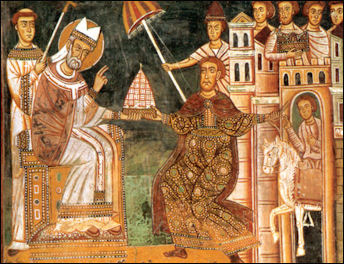
In A.D. 325, the Council of Nicaea was convened by Emperor Constantine I. The council marked an important point in Christian history. We now had a public authority intervening and making ‘decisions’ about the teachings of the gospel. ‘Truth’ was what the council said it was. Just as today, the media, acting on instruction from above, dictates ‘Truth’ as we are required to accept. The Council of Nicaea decided what should thereafter be regarded as the ‘orthodox’ belief. If the Council said Jesus was the son of God — he was the son of God — no argument.
Constantine became Pope-like. The general ecumenical council, in Nicaea in 325ad, had settled questions of doctrine. The most significant decision was the adoption of ‘Nicene creed’. Henceforth, the assertion that the denial of Christ’s divinity was a heresy. This became the basis of Church doctrine. To departed from the creed was to be branded a ‘heretic’. In our time, we white Christians have become used to being branded ‘racists’ and ‘white supremists’.
Interestingly, one of the first things Constantine does is start persecuting other Christians. Christians who don’t accept the Old Testament are targeted. This is interesting as Jesus brought in the ‘new’ as a better way than the old’. The list of enemies grew. Constantine helps the bishops run a unitary policy of what a Christian is required to believe. [1]
Christianity had humble beginnings. Its early followers practiced privately in humble abodes. Constantine takes it to the city. He builds beautiful basilicas and architecturally ambitious projects in the city. The sacred space of the Temple Mount is abandoned and he relocates the centre of Christianity to his city fat away from the locations where Christ had suffered at the hands of the agents of his predecessors, where Jesus had been buried. He built great basilicas all splendid and beautiful, which also magnified his reputation. Constantine portrayed himself as a non-apocalyptic Messiah for the church. Constantine stamped his authority over the Church. He creates a comfortable symbiotic relationship between the empire and the Church. This becomes the cultural powerhouse of Europe and the West.
So:
- we have the Christianity as taught by Jesus that I regard as the value system that mothers pass to their children, particularly their boys. My mother brought me up in the image of Jesus, whether she knew it or not. This is reinforced by fathers. It’s core tenet is ‘Be good to others.’ and embraces what I call “Common Decency”.
- We have the Christianity as spread by Paul. Sometimes called “Paulianity”.
- And we have the Christianity of the Church with all its formalities. It hints that you are a ‘good Christian of you attend Church regularly and support the Church structure. Jesus made no such demand. With Jesus, you could pray in private and you will be judged on how you treat others — on your good deeds, seen or not.
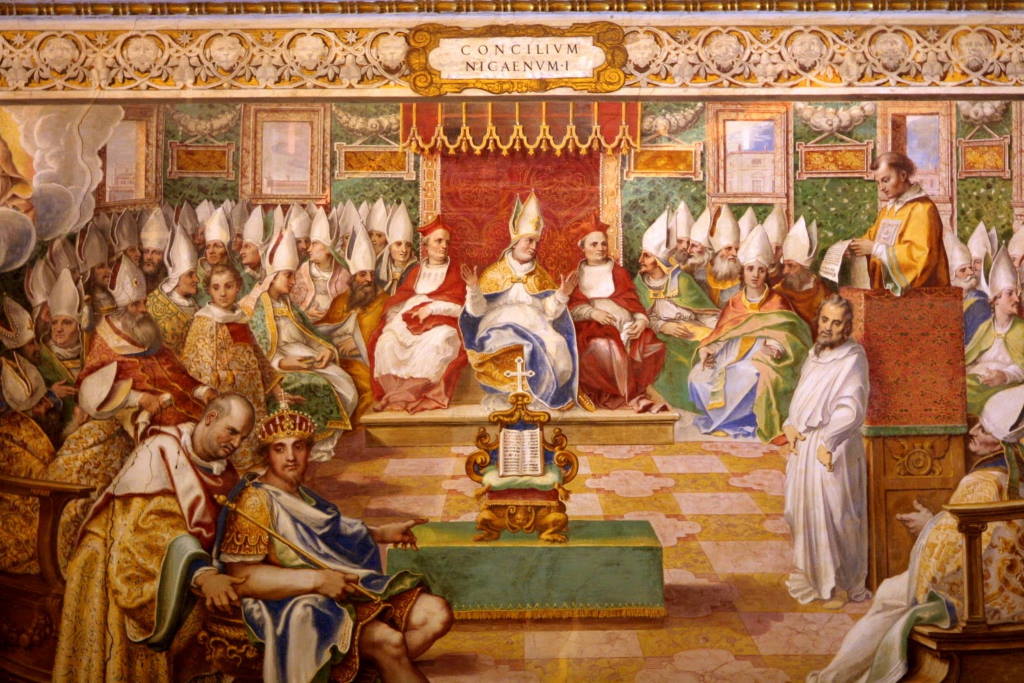
The Council of Nicaea of the year 325 was held in Nicaea which is the now the city of Iznik In Turkey. It brought in thousands of priests, hundreds of bishops, and the Roman Emperor in person. Discussed was the Holy trinity and the linkage of the Father, Son, and Holy Ghost. To be decided was whether Jesus was divine or merely a prophet. The Muslims later claim that he was a prophet, and at that, a very good prophet. The Council of Nicaea declared by a vote that he was divine. They even decided the annual date for Easter. Previously, there had been practical difficulties in deciding the precise date of Easter.
This meeting pushed on to us the ‘Roman’ version of Christianity and the Nestorian version was rejected. And thus we have the ‘absolute truth’ decided by a vote by a room full of priests presided over by an emperor. Christ’s divinity, the Virgin Birth and the Holy Trinity were now what we might call: “Gospel truths”. Denial of Christ’s divinity was a heresy. Disagreeing with the priests vote was heresy. To teach what many bishops and priests had previously taught suddenly became heresy.
There are modern examples. To deny the death of six million Jews is the new heresy even though there were only around four million Jews in the areas under National Socialist control. Yet there are millions of ‘Holocaust Survivors’. Official figures suggest there are six and a half million ‘official’ holocaust survivors. If you don’t support ‘Black Lives Matter’, you are racist. If you want the survival of the diminishing white race, you are racist.
Athanasius, a renegade in Alexandria, opposed some of Constantine’s policies. He exiled to distant Trier. Christians who had ‘lapsed’ from the ‘official orthodoxy’ were allowed to return to the Church after undergoing a mild penance.
Up until 324, Emperor Constantine had only ruled over half of the Roman Empire. He then secured authority over the whole of the Roman Empire. It was convenient that he unify the belief systems and teachings within his Church. So was it the Church of Jesus or the Church of Constantine. People were required to believe what Constantine required them to believe. Uniformity of belief reduced disputes within the church under his rule.
There has been many Pagans throughout the Roman Empire and to make the transition to this new religion, Christianity, or the Church version of it, addopted some pagan procedures. Waving of smelly stuff at meetings was not Jesus inspired. This is an image of Jesus teaching the crowd:
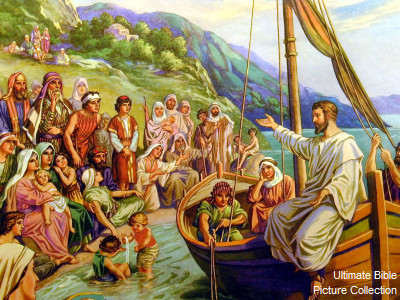
But Constantine upgraded to Basilicas, provided you went along with his beleif systems:

Even though the Council of Nicea standardised the ‘truth’, it was not uniformly put into effect due to divergence of thoughts on the part of priests, many of whom had been to the big meeting. This inconsistency caused issues not the least of which were accusations which put priests in the position of accusations of heresy. Like the modern day court of justice, truth became irrelevant. Further councils were held to rectify thoughts and teachings. Thus arises the term “holy law” and that seems to be based on Moses and his ‘Ten Commandments’. Unfortunately, Jesus did not provide a system for running a nation, so we inherited nations-states that have books full of negative rules: “Don’t do this or we hang you from a tree.” “Don’t do that or you will be buried up to your neck and we will throw rocks at you.” The primary rule of Jesus is Common Decency — “Be good to others.”
The Emperor Julian, who ruled for about three years from 361ad to 363ad, about twenty-five years after Constantine’s death, was a Pagan follower of Mithraism. He made efforts to re-instate paganism as the dominant religion. He was only partly successful.
Paganism was being extinguished by Christianity. In reality, the Catholic Church adopted pagan practices and beliefs to enable it to merge into Roman society. Some say that Constantine ‘Christianised’ a pre-existing Pagan Church. In the procedures and symbols of the Roman Catholic Church, one finds, rebranded pagan myths, deities, festivals, and rituals. I give you three Catholic practices that can be traced back to the pagan origins.
- The Holy Communion parallels pre-Christian Greco-Roman and Egyptian rituals that involved eating the body and blood of a god.
- Some of Catholic holidays and myths, such as Christmas, Easter, and Mardi Gras, map to pre-Christian fertility festivals.
- The practice of ‘praying to saints’ is a replacement for the ‘idolatry’ and goddess worship.
Catholic Fat Tuesday, also known as Mardi Gras, has origins to the pre-Christian celebration of Lupercalia. this was a holiday in honour of the Roman god of fertility. This custom involved feasting, drinking, and “carnal behavior.” Mardi Gras matches this when Catholics and non-Catholics eat and party before abstaining for forty days for Lent. You may notice that pagan goddesses can be found in the forms of Saint Brigid and the Virgin Mary.
Christianity did not become the legal religion of the Roman Empire until the reign of Theodosius I (A.D. 379-395). Theodosius also declared other religions illegal:
It is necessary that the privileges which are bestowed for the cultivation of religion should be given only to followers of the Catholic faith. We desire that heretics and schismatics be not only kept from these privileges, but be subjected to various fines. Constantine Augustus
and
We desire that all the people under the rule of our clemency should live by that religion which divine Peter the apostle is said to have given to the Romans, … that is that we should believe in the one deity of Father, Son, and Holy Spirit with equal majesty and in the Holy Trinity according to the apostolic teaching and the authority of the gospel.
Gratian, Valentinian and Theodosius Augusti.
So “one deity of Father, Son, and Holy Spirit” occurs because a council of half informed priests said it should and the Emperor made it mandatory. But the problem of the deity of Jesus never went away. It has caused constant struggles within the Church, particularly in the centuries following Emperor Constantine. If you wring the topic up in a group of Christians, you will be verbally attacked.
Let me take you down another track. If Jesus is the son of god, is it possible for him to die a human death?
And another track. There are a lot of Muslims in the world and their viewpoint is to be considered. Muslims accept Jesus Christ as a great prophet, but they do not accept the New Testament account about His death on the cross or His resurrection from the dead. Muslims basically do not believe that God would allow a prophet to be killed in the manner that the Church claims that Jesus was killed. Muslims believe that they killed the wrong bloke. It was not Jesus on the cross. The mob that wanted Jesus dead believed that he had been crucified, but they had killed a different person.
The Quran says:
And for their unbelief, and their uttering against Mary a mighty calumny, and for their saying, “We slew the Messiah, Jesus, son of Mary, the Messenger of God”…yet they did not slay him, neither crucified him, only a likeness of that was shown to them. Those who are at variance concerning him surely are in doubt regarding him, they have no knowledge of him, except the following of surmise; and they did not slay him of certainty…no indeed; God raised him up to Him; God is Almighty, All-Wise. There is not one of the People of the Book but will assuredly believe in him before his death, and on the Resurrection Day, he will be a witness against them.
(Quran 4:156-159)
It was not Jesus that was crucified, but a likeness of Him. According to Islam, it was Judas or Simon the Cyrene, the man who carried Jesus’ cross, which was actually crucified in His place.
The general view within Islam is that this verse “affirms categorically that Christ did not die on the cross and that God raised him to Godself.” [2]
If the Quran and Muslim belief were correct that Jesus did not die on the cross, it would follow that He did not come back from the dead three days later. Muslims do not accept the New Testament teaching of the resurrection of Jesus Christ. Mustafa Akyol sums it up with:
“With Christians, we (Muslims) agree that Jesus was born of a virgin, that he was the Messiah, and that he is the Word of God. Surely, we do not worship Jesus, like Christians do. Yet still, we can follow him. In fact, given our grim malaise and his shining wisdom, we need to follow him.”
Mustafa Akyol (The Islamic Jesus, St Martin’s Press)
There is no possibility of compromise between these the views of Muslims and the Church. Consider again the sentence (Haleem version):
— [Jews] said, ‘We have killed the Messiah, Jesus, son of Mary, the Messenger of God.’ (They did not kill him, nor did they crucify him, though it was made to appear like that to them; those that disagreed about him are full of doubt, with no knowledge to follow, only supposition: they certainly did not kill him.)
The Pharisees believe he was dead but they were duped. It was not Jesus who was crucified, but someone who looked like him.
This should not affect our love of Christianity. As a boy, I was brought up in the likeness of Jesus, whether my mother knew it or not. Jesus is a role model. He is a very good role model. He is certainly better than Mohamed. So, in reality, Christianity is still a wonderful religion even if it were determined that Jesus was not real like Father Christmas. We need to distinguish Christianity as it is passed down from parents to children and the wonderful society that creates and the Christianity that is pedalled by the Church which strays from the message of Jesus. With the Church, there is always the hint that you are a good Christian if you go to church each week and say your prayers. The church also puts an accent on ‘faith’. Even Martin Luther suggested that one could go to heaven by faith alone. Catholics, at times, suggested that you should give ‘tythes’ (money) to the Church. The young roughnecks that I see around town wearing crosses, never go to church and don’t have good regard for the church, but they have the concept of common decency tied up in between the lines of the teachings of Jesus. They also say things like: “That is wrong.” without referring to any rule or law which is part of what I call the ‘Philosophy of Jesus’.
[1] Source: Shaye I.D. Cohen, Samuel Ungerleider Professor of Judaic Studies and Professor of Religious Studies Brown University, Frontline, PBS, April 1998. [2] https://journal.rts.edu/article/it-was-made-to-appear-like-that-to-them-islams-denial-of-jesus-crucifixion-in-the-quran-and-dogmatic-tradition
